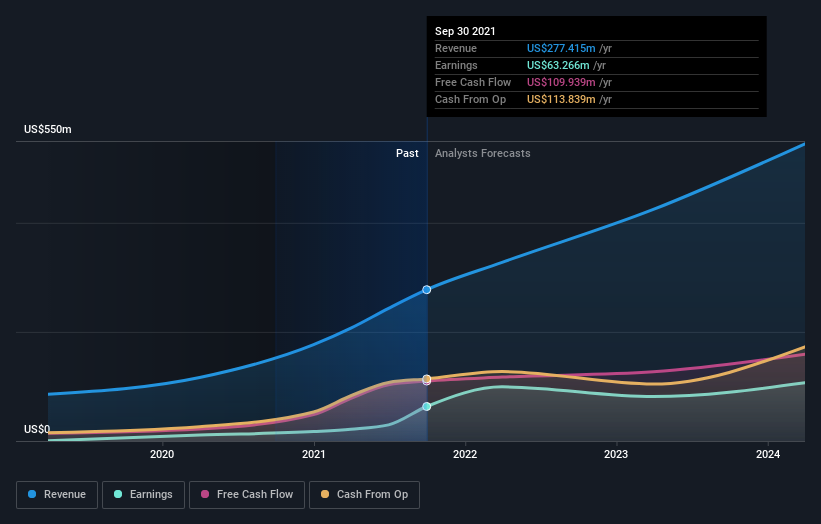- United States
- /
- Healthtech
- /
- NYSE:DOCS
Individual investors who have a significant stake must be disappointed along with institutions after Doximity, Inc.'s (NYSE:DOCS) market cap dropped by US$829m
A look at the shareholders of Doximity, Inc. (NYSE:DOCS) can tell us which group is most powerful. The group holding the most number of shares in the company, around 31% to be precise, is individual investors. Put another way, the group faces the maximum upside potential (or downside risk).
Following a 8.3% decrease in the stock price last week, individual investors suffered the most losses, but institutions who own 28% stock also took a hit.
Let's delve deeper into each type of owner of Doximity, beginning with the chart below.
Check out our latest analysis for Doximity

What Does The Institutional Ownership Tell Us About Doximity?
Many institutions measure their performance against an index that approximates the local market. So they usually pay more attention to companies that are included in major indices.
Doximity already has institutions on the share registry. Indeed, they own a respectable stake in the company. This suggests some credibility amongst professional investors. But we can't rely on that fact alone since institutions make bad investments sometimes, just like everyone does. It is not uncommon to see a big share price drop if two large institutional investors try to sell out of a stock at the same time. So it is worth checking the past earnings trajectory of Doximity, (below). Of course, keep in mind that there are other factors to consider, too.

Hedge funds don't have many shares in Doximity. The company's CEO Jeffrey Tangney is the largest shareholder with 27% of shares outstanding. For context, the second largest shareholder holds about 13% of the shares outstanding, followed by an ownership of 4.8% by the third-largest shareholder.
On looking further, we found that 52% of the shares are owned by the top 5 shareholders. In other words, these shareholders have a meaningful say in the decisions of the company.
Researching institutional ownership is a good way to gauge and filter a stock's expected performance. The same can be achieved by studying analyst sentiments. There are plenty of analysts covering the stock, so it might be worth seeing what they are forecasting, too.
Insider Ownership Of Doximity
While the precise definition of an insider can be subjective, almost everyone considers board members to be insiders. The company management answer to the board and the latter should represent the interests of shareholders. Notably, sometimes top-level managers are on the board themselves.
I generally consider insider ownership to be a good thing. However, on some occasions it makes it more difficult for other shareholders to hold the board accountable for decisions.
Our most recent data indicates that insiders own a reasonable proportion of Doximity, Inc.. It is very interesting to see that insiders have a meaningful US$2.5b stake in this US$9.1b business. It is good to see this level of investment. You can check here to see if those insiders have been buying recently.
General Public Ownership
The general public-- including retail investors -- own 31% stake in the company, and hence can't easily be ignored. While this group can't necessarily call the shots, it can certainly have a real influence on how the company is run.
Private Equity Ownership
With a stake of 13%, private equity firms could influence the Doximity board. Sometimes we see private equity stick around for the long term, but generally speaking they have a shorter investment horizon and -- as the name suggests -- don't invest in public companies much. After some time they may look to sell and redeploy capital elsewhere.
Next Steps:
It's always worth thinking about the different groups who own shares in a company. But to understand Doximity better, we need to consider many other factors. For instance, we've identified 1 warning sign for Doximity that you should be aware of.
If you are like me, you may want to think about whether this company will grow or shrink. Luckily, you can check this free report showing analyst forecasts for its future.
NB: Figures in this article are calculated using data from the last twelve months, which refer to the 12-month period ending on the last date of the month the financial statement is dated. This may not be consistent with full year annual report figures.
New: Manage All Your Stock Portfolios in One Place
We've created the ultimate portfolio companion for stock investors, and it's free.
• Connect an unlimited number of Portfolios and see your total in one currency
• Be alerted to new Warning Signs or Risks via email or mobile
• Track the Fair Value of your stocks
Have feedback on this article? Concerned about the content? Get in touch with us directly. Alternatively, email editorial-team (at) simplywallst.com.
This article by Simply Wall St is general in nature. We provide commentary based on historical data and analyst forecasts only using an unbiased methodology and our articles are not intended to be financial advice. It does not constitute a recommendation to buy or sell any stock, and does not take account of your objectives, or your financial situation. We aim to bring you long-term focused analysis driven by fundamental data. Note that our analysis may not factor in the latest price-sensitive company announcements or qualitative material. Simply Wall St has no position in any stocks mentioned.
About NYSE:DOCS
Doximity
Operates as a digital platform for medical professionals in the United States.
Outstanding track record with flawless balance sheet.
Similar Companies
Market Insights
Community Narratives





